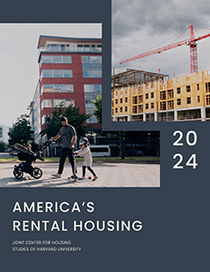New Report Shows Rent Is Unaffordable for Half of Renters as Cost Burdens Surge to Record Levels

CAMBRIDGE, MA – Climbing rents have propelled cost burdens to staggering new heights: in 2022, half of all US renters were cost burdened. The number of renter households spending more than 30 percent of their income on rent and utilities rose by 2 million in just three years to a record high of 22.4 million, according to America’s Rental Housing 2024, a new report being released January 25 by the Harvard Joint Center for Housing Studies. Among these renters, 12.1 million had severe burdens, paying over half of their income for housing, also an all-time high. [INTERACTIVE] And while rental markets are finally cooling, evictions have risen, the country is seeing the highest homelessness counts on record, and the need for rental assistance is greater than ever.
Rental Markets Cool After Overheating During the Pandemic
Rent growth has almost completely stopped, following historically high rent increases in 2021 and 2022. In the third quarter of 2023, rent growth plummeted for professionally managed apartments to just 0.4 percent, down from 15.3 percent in early 2022. “This abrupt deceleration was geographically widespread, with rents even falling in some markets,” says Whitney Airgood-Obrycki, a Senior Research Associate at the Harvard Joint Center for Housing Studies and lead author of the report. “While the slowdown is a welcome change for renters, asking rents still remain well above pre-pandemic levels.” Amid market slackening and high financing costs, multifamily starts have fallen sharply in recent months. In October 2023, starts receded to 402,000 units, a 30 percent decrease year over year. Nevertheless, units that were already in the construction pipeline continue to come online in large numbers. A total of 436,000 multifamily units were completed in the third quarter of 2023, the highest number since 1988 and up about a third from pre-pandemic levels.
Unaffordability Reaches New Heights
The extended period of rising rents during the pandemic put unaffordability at an all-time high. The share of cost-burdened renters rose to 50 percent, up 3.2 percentage points from 2019, and the financial strain has been felt across the income spectrum. [INTERACTIVE] Since 2019, cost-burden shares have risen the most for middle-income renter households earning between $30,000 and $74,999 annually. Higher-income households also saw their burden rate increase by 2.2 percentage points. Even lower-income renters making less than $30,000 annually saw their cost-burden rate rise by 1.5 percentage points to 83 percent, with the majority (65 percent) experiencing severe burdens, marking yet another all-time high.
US Continues to Lose Low-Rent Units and Rents Significantly Outpace Incomes
The country’s dwindling supply of low-rent units has only made things worse. In 2022, just 7.2 million units had contract rents under $600, a loss of 2.1 million units since 2012. [INTERACTIVE] The spike in rents during the pandemic accelerated this trend, with more than half a million low-rent units lost between 2019 and 2022. Additionally, rent increases are outpacing income gains. In 2022, median rents were 21 percent higher than they were in 2001, while renters’ incomes have risen just 2 percent during the same period.
Record Number of People Are Experiencing Homelessness
Though pandemic-era protections and financial supports temporarily reduced eviction filings, these resources have largely expired, and housing instability is again on the rise. Homelessness has grown, hitting an all-time high of 653,100 people in January 2023. [INTERACTIVE] Indeed, the number of people experiencing homelessness jumped by nearly 71,000 in just one year and in 2023, the total number of people experiencing homelessness in unsheltered locations reached 256,610, the highest on record.
Rental Stock Is Aging, and Needs Investments in Energy Efficiency and Climate Risk Mitigation
The rental stock is older than it has ever been: the median age was 44 years in 2021, up from 34 years two decades ago. And many units fall short of baseline habitability and safety: nearly 4 million renter households live in physically inadequate units. The rental stock also needs significant energy efficiency and electrification improvements. Rental homes—especially those in small multifamily buildings—use more energy per square foot than owner-occupied homes. Additionally, more than 18 million occupied rental units (41 percent) are located in areas with substantial expected losses from weather and climate hazards such as wildfires, flooding, earthquakes, and hurricanes.
Need for Rental Assistance Is Greater Than Ever
During the pandemic, the increased resources demonstrated that financial assistance and supports keep tenants stably housed and landlords solvent. “As these resources have expired, however, the housing safety net is once again overwhelmed and underfunded,” says Chris Herbert, Managing Director of the Center. “And while states and localities have acted to fill some of the gaps, a larger commitment from the federal government is required to expand housing supports and preserve and improve the existing affordable stock. Only then will the nation finally make a meaningful dent in the housing affordability crisis making life so difficult for millions of people.”
Download the full report along with interactive maps and data.
MEDIA CONTACT
Kerry Donahue, Director of Communications
(617) 495-7640, [email protected]
